Stabilization Ponds - 7...
Introduction...
Waste stabilization ponds (WSPs) are usually the most appropriate method of domestic and municipal wastewater
treatment in developing countries, where the climate is most favourable for their operation WSPs are low-cost
(usually least-cost), low-maintenance, highly efficient, entirely natural and highly sustainable. The only energy
they use is direct solar energy, so they do not need any electromechanical equipment, saving expenditure on electricity
and more skilled operation. They do require much more land than conventional electromechanical treatment processes such
as activated sludge but land is an asset which increases in value with time, whereas money spent on electricity for
the operation of electromechanical systems is gone forever). WSP systems comprise one or more series of different types
of ponds. Usually the first pond in the series is an anaerobic pond, and the second is a facultative pond. These may need
to be followed by maturation ponds, but this depends on the required final effluent quality which in turn depends on
what is to be done with the effluent: used for restricted or unrestricted irrigation; used for fish or aquatic vegetable culture; or discharged into surface water or groundwater.
Many wastewater treatment plants (WwTP) of all kinds in developing countries do not function properly. Parr and Horan
(1994) found that there are three principal reasons for WwTP failure: a lack of technical knowledge; failure to consider
all relevant local factors at the pre-design stage; and inappropriate discharge standards. As a result, wrong decisions are often made and inappropriate unsustainable treatment processes are selected and implemented This is then exacerbated by the absence of any real incentive to operate the WwTP correctly once it has been commissioned. It is therefore essential for
the long-term sustainability of WwTP that simple efficient technologies such as WSPs are always considered at the
pre-design (or feasibility) stage. An honest comparison of the costeffectiveness of wastewater treatment technologies
will almost always favour the selection of WSPs in warm-climate countries (see Section WSP Costs).
Wastewater Treatment in WSPs...
WSPs are one of the main natural wastewater treatment methods. They are man-made earthen basins, comprising at any one location one or more series of anaerobic, facultative and, depending on the effluent quality required, maturation ponds.
WSPs are particularly suited to tropical and subtropical countries since sunlight and ambient temperature are key factors
in their process performance. Prior to treatment in the WSPs, the wastewater is first subjected to preliminary treatment -
screening and grit removal - to remove large and heavy solids. The design of this preliminary treatment stage is the same
as that used for conventional electromechanical WwTP, but for WSPs the simplest systems are generally used (i.e. manually raked screens and manually cleaned constant-velocity grit channels).
The wastewater treatment processes that occur in anaerobic, facultative and maturation ponds are described in detail in Section 3 of the Design Manual for WSPs in India (see also Section 3-1). Basically, primary treatment is carried out in anaerobic ponds, secondary treatment in facultative ponds, and tertiary treatment in maturation ponds. Anaerobic and
facultative ponds are for the removal of organic matter (normally expressed as "biochemical oxygen demand" or BOD), Vibrio cholerae and helminth eggs; and maturation ponds for the removal of faecal viruses (especially rotavirus, astrovirus and norovirus), faecal bacteria (for example, Salmonella spp., Shigella spp., Campylobacter spp. and pathogenic strains of Escherichia coli), and nutrients (nitrogen and phosphorus). Due to their high removal of excreted pathogens, WSPs produce effluents that are very suitable for reuse in agriculture and aquaculture. The reuse of WSP effluents is discussed in
Section Reuse of WSP effluents.
The process design of anaerobic, facultative and maturation ponds is detailed in Section 4-1 of the India Manual;
the physical design of WSPs is detailed in Section 5-2, and WSP operation and maintenance (which is very simple, but essential) in Section 6-3. Each is described briefly here and in Box 1. More detailed information on the microbiological
processes in WSPs is given in the specialized literature listed in TOP Resources/References of this TOP.
Anaerobic Ponds...
Anaerobic ponds are the smallest units in the series. They are sized according to their "volumetric organic loading",
which means the quantity of organic matter, expressed in grams of BOD5 per day, applied to each cubic metre
of pond volume. Ponds may receive volumetric organic loadings in the range of 100 to 350 g BOD5 / m3 . day, depending on the design temperature.
Design Equations for WSPs...
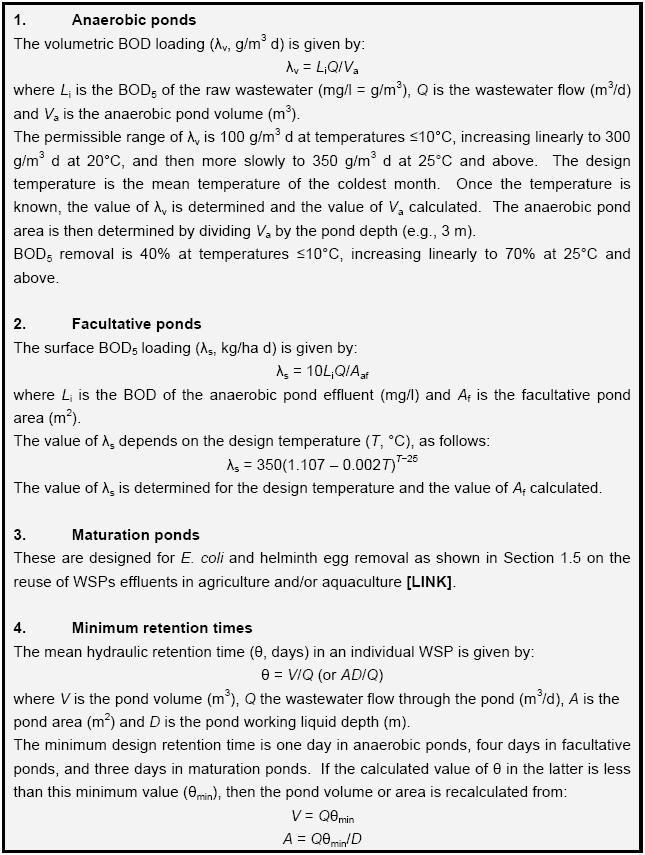
These high loadings produce a strict anaerobic environment throughout the pond volume (i.e., there is no dissolved oxygen present and the redox potential is negative). The depth of anaerobic ponds is in the range 2-5 m; the precise value depends on the ground conditions and local excavation costs (which increase with depth) - depths are often 3-4 m.
Anaerobic ponds work extremely well in warm climates: for example, a properly designed pond will achieve around 60 percent BOD5 removal at 20OC and over 70 percent at 25OC and above. Organic matter removal in anaerobic ponds is governed by the same mechanisms that occur in all other anaerobic reactors (Mara et al., 1992; Pena, 2002). A retention time of one day is sufficient for wastewaters with a BOD5 <= 300 mg / L at temperatures above 20OC. Odour nuisance from anaerobic ponds, typically due to hydrogen sulphide, has always been a concern for design engineers. However, odour is not a problem provided that the anaerobic pond is properly designed and the sulphate concentration in the raw wastewater is less than 500 mg SO4 - 2 / L.
Facultative Ponds...
These ponds are of two types: primary facultative ponds that receive raw wastewater (after screening and grit removal) and secondary facultative ponds that receive settled wastewater from the primary stage (usually the anaerobic ponds effluent). Facultative ponds are designed for BOD5 removal based on their "surface organic loading. The term refers to the quantity of organic matter, expressed in kilograms of BOD5 per day, applied to each hectare of pond surface area; thus the overall units are kilograms of BOD5 per hectare of facultative pond surface area per day - i.e., kg BOD5 / ha . day. A relatively low surface organic loading is used (usually in the range of 80-400 kg BOD5 / ha . day, depending on the design temperature) to allow for the development of an active algal
population. The depth of facultative ponds is in the range 1-2 m, with 1.5 m being most common.
The maintenance of a healthy algal population is very important as the algae generate the oxygen needed by bacteria to
remove the BOD5 (see Figure - 1). The algae give facultative ponds a dark green colour. Ponds may occasionally appear red or pink, due to the presence of anaerobic purple sulphide-oxidising photosynthetic bacteria (Mara and Pearson, 1986). This change in facultative pond ecology occurs due to slight BOD5 overloading, so colour changes in facultative ponds are a good qualitative indicator of pond function. The concentration of algae in a well-functioning facultative pond depends on loading and temperature. It is usually in the range 500-1,000 ΅g chlorophyll-a per litre
(algal concentrations are best expressed in terms of the concentration of their principal photosynthetic pigment). The photosynthetic activity of the algae results in a diurnal variation of dissolved oxygen (DO) concentration and pH. The DO concentration can rise to more than 20 mg/l (i.e., highly supersaturated conditions) and the pH to more than 9.4 (these
are both important factors in the removal of faecal bacteria and viruses; Curtis et al., 1992).
BOD5 removal in primary facultative ponds is about 70 percent on an unfiltered basis and more than 90 percent
on a filtered basis (filtering the sample before BOD5 analysis excludes the BOD5 due to the algae
in the sample; this "algal BOD5" is very different in nature to ordinary wastewater BOD5 or
"non-algal BOD5"). Some regulators specify effluent BOD5 requirements for WSPs in terms of
filtered BOD5 - for example, in the European Union WSP effluents are required to achieve <= 25 mg filtered
BOD5 / L (Council of the European Communities, 1991). Other regulators should be encouraged to apply similar standards.
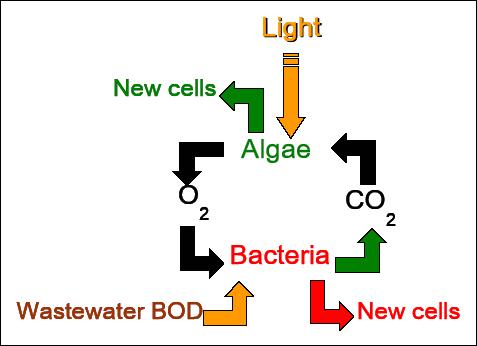 Maturation Ponds...
Maturation ponds receive the effluent from the facultative ponds and their size and number depends on the required bacteriological quality of the final effluent. They are shallower than facultative ponds with a depth in the range
1-1.5 m, with 1 m being optimal (depths of less than 1 m encourage rooted macrophytes to grow in the pond and so
permit mosquitoes to breed). Because of the lower organic loadings received by maturation ponds, they are well oxygenated throughout their depth. The algal populations are much more diverse than that in facultative ponds; algal diversity
increases from pond to pond along the series. The main mechanisms of faecal bacterial and viral decay are driven by algal activity along with photo-oxidation. Further details on the removal mechanisms in maturation ponds can be found in Curtis
et al. (1992).
Maturation Ponds...
Maturation ponds receive the effluent from the facultative ponds and their size and number depends on the required bacteriological quality of the final effluent. They are shallower than facultative ponds with a depth in the range
1-1.5 m, with 1 m being optimal (depths of less than 1 m encourage rooted macrophytes to grow in the pond and so
permit mosquitoes to breed). Because of the lower organic loadings received by maturation ponds, they are well oxygenated throughout their depth. The algal populations are much more diverse than that in facultative ponds; algal diversity
increases from pond to pond along the series. The main mechanisms of faecal bacterial and viral decay are driven by algal activity along with photo-oxidation. Further details on the removal mechanisms in maturation ponds can be found in Curtis
et al. (1992).
Maturation ponds only achieve a small additional removal of BOD5, but they make a significant contribution to nitrogen and phosphorus removal. Total nitrogen removal in a whole WSP system is often above 80 percent and ammonia removal is generally more than 90 percent (these figures depend on the number of maturation ponds included in the WSP system). Phosphorus removal in WSPs is lower (usually about 50 percent). Examples of WSP series (anaerobic ponds + facultative
ponds + maturation ponds) are shown in Figures 2-4.
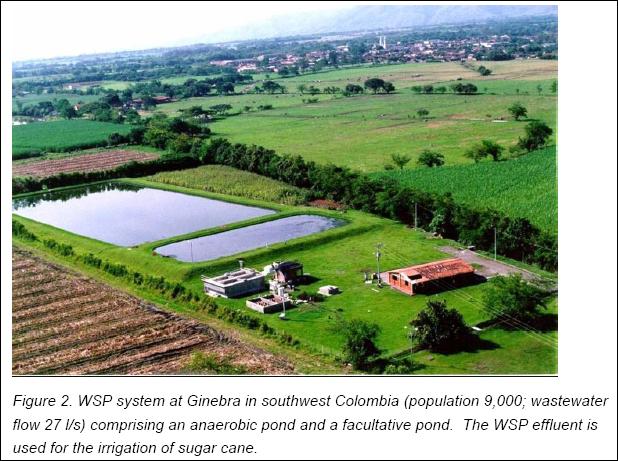
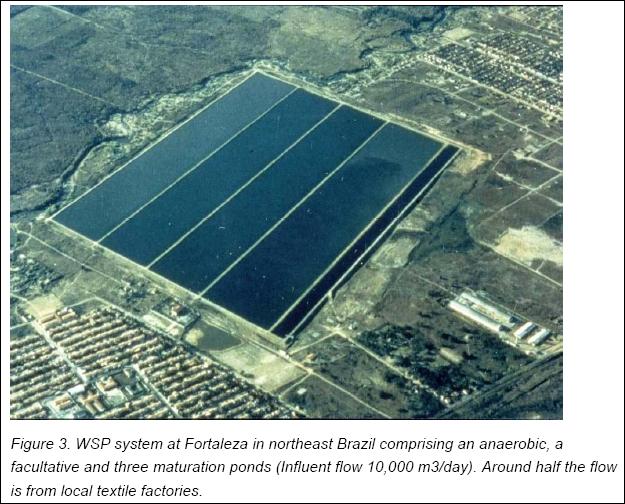
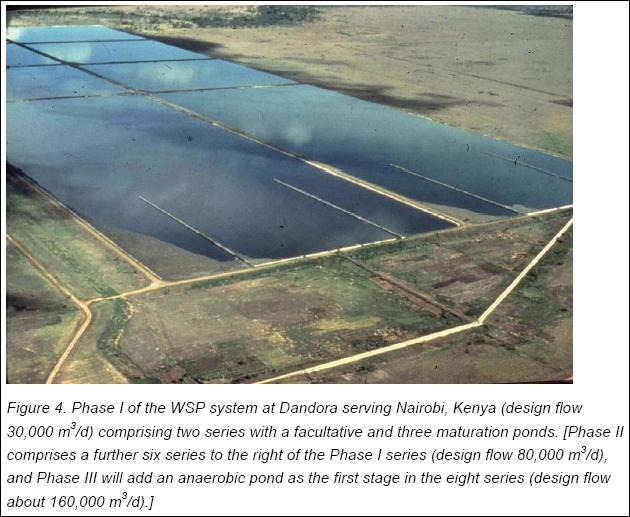 Construction of WSPs...
Full details of the physical design of WSPs can be found in Section 5 of the India Manual 4, and in Wastewater and Evaporation Lagoon Construction - 5 published by the Environment Protection Agency of South Australia (EPA SA, 2004). A
brief introduction to WSP construction is given below. The site selected for WSPs should be at least 500 m downwind of
the nearest housing. Ideally it should have a reasonably flat topography and the soil should have an in situ coefficient
of permeability of less than 10 - 7 m / sec (WSP construction costs increase with increasing site gradients,
and soils with a coefficient of more than 10 - 6 m / sec require the ponds to be lined). The principal construction activity is earthmoving (Figure 5) and there should be a good balance between cut and fill. Embankments
should be made from the local soil compacted in 250 mm layers to 90 percent of its maximum dry density, such that its coefficient of permeability is less than 10 - 7 m / sec. Internal embankment slopes are commonly 1 in 3
(i.e. 1 m vertically per 3 m horizontally) and external slopes 1 in 2. Slowgrowing grass is planted on the embankment
to improve slope stability. Embankment protection is provided at top water level to prevent erosion due to wind-induced
wave action (Figures 6 and 7).
Construction of WSPs...
Full details of the physical design of WSPs can be found in Section 5 of the India Manual 4, and in Wastewater and Evaporation Lagoon Construction - 5 published by the Environment Protection Agency of South Australia (EPA SA, 2004). A
brief introduction to WSP construction is given below. The site selected for WSPs should be at least 500 m downwind of
the nearest housing. Ideally it should have a reasonably flat topography and the soil should have an in situ coefficient
of permeability of less than 10 - 7 m / sec (WSP construction costs increase with increasing site gradients,
and soils with a coefficient of more than 10 - 6 m / sec require the ponds to be lined). The principal construction activity is earthmoving (Figure 5) and there should be a good balance between cut and fill. Embankments
should be made from the local soil compacted in 250 mm layers to 90 percent of its maximum dry density, such that its coefficient of permeability is less than 10 - 7 m / sec. Internal embankment slopes are commonly 1 in 3
(i.e. 1 m vertically per 3 m horizontally) and external slopes 1 in 2. Slowgrowing grass is planted on the embankment
to improve slope stability. Embankment protection is provided at top water level to prevent erosion due to wind-induced
wave action (Figures 6 and 7).
Pond lining, if required, is normally a plastic membrane covering the entire pond base and the embankments. Membrane
joints need to be watertight. Alternatively the ponds can be sealed with a 250 mm layer of clay. Pond inlets and
outlets should be constructed carefully and located in diagonally opposite corners of the pond to minimize hydraulic short-circuiting (see Shilton and Harrison, 2003). Inlets to facultative ponds and maturation ponds should be provided
with a "scum box" (Figure 8) to minimize the amount of scum on the pond surface, and outlets should be provided with a
simple scum guard to prevent any scum or duckweed that may be growing on the pond surface from leaving the pond (scum and duckweed removal is an essential WSP maintenance requirement; see Section Operations and Maintenance of WSPs (Figure 9).
WSP start-up procedures are explained in Section 1.6.
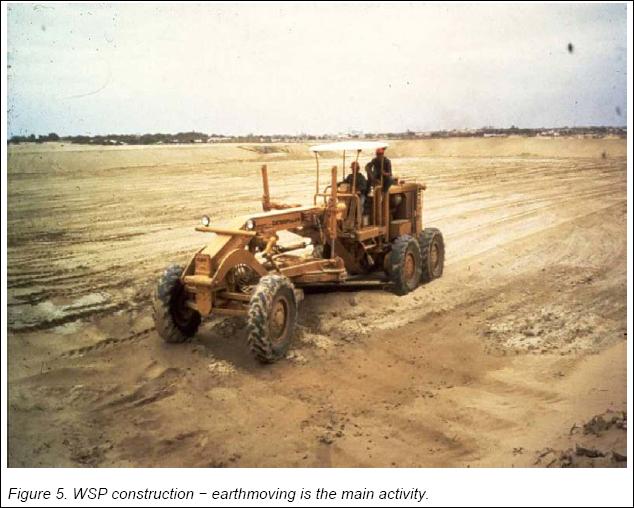
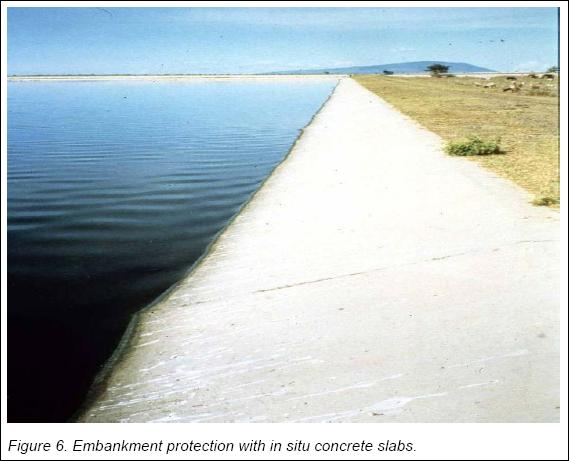
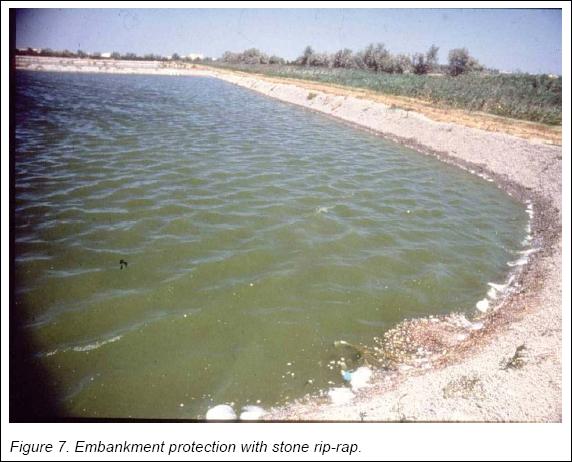
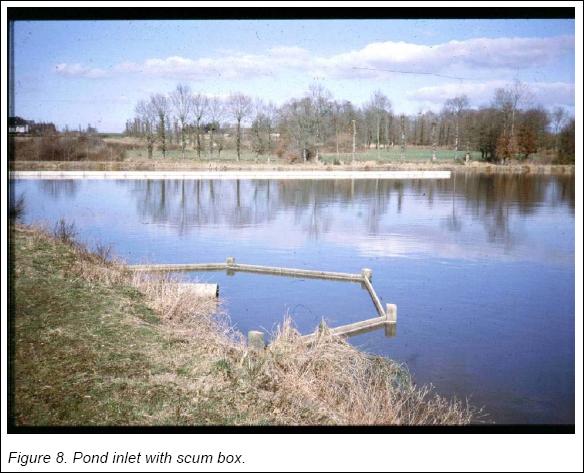
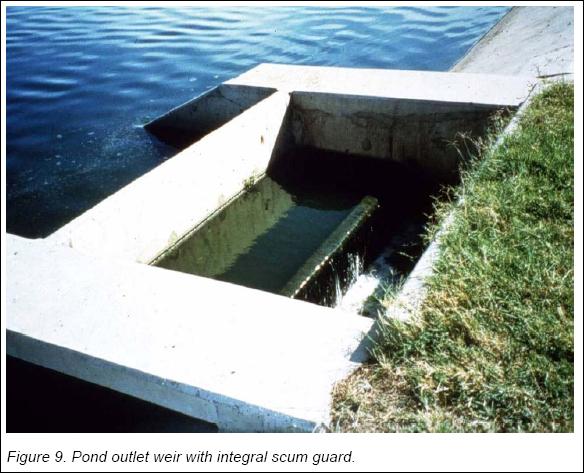
WSP Costs...
Case Study in Sana'a, Yemen...
A rigorous economic analysis was undertaken for a hypothetical large WSP system for the city of Sana'a in the Yemen
(Arthur, 1983) (Table 1). The overall cost of each of four alternative treatment systems (WSPs, aerated lagoons,
oxidation ditches and biological filters) is given as a net present value (NPV), which is a figure that combines
construction costs with future operational costs discounted to their present value. This least-cost analysis found that
WSP costs are dictated by the cost of land, the discount rate used and the value of the land at the end of the project
life (taken in this study as 25 years). WSPs were found to be the least-cost solution for land prices in the range
US $ 50,000-150,000 per hectare, depending on the value of the discount rate used (5-15 %). These land prices refer, of course, only to the conditions of Arthur's case study. However, they do indicate that WSPs are very competitive even at
high land costs.
Arthur's study highlights an extremely important and universal aspect of WSP economics, which is that their main capital
item (land) is recoverable. Furthermore, since land is an appreciating capital item, it can appear as such in company accounts. Including the endof - project value of the land dramatically alters the net present values in favour of
WSPs - their NPV decreases by nearly 90 percent (Table 2). Consideration of the end-of-project value of land used for
WSPs is not just a hypothetical or academic exercise - for example, it has been extremely profitable in California,
where WSP land in the city of Concord increased in real terms by US $ 270,000 (1975 dollars) per ha during the 20-year
period 1955-1975 (Oswald, 1976).
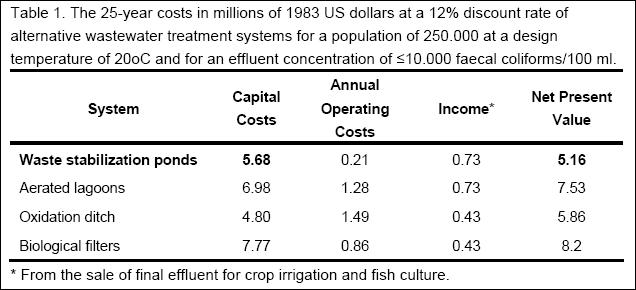
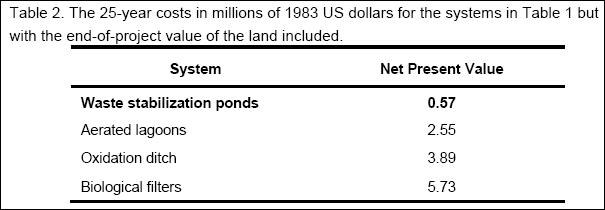
Arthur's study was done in 1983 and did not include treatment technologies such as upflow anaerobic sludge blanket (UASB) reactors and constructed wetlands. Also, the effluent quality used (<= 104 faecal coliforms/100 ml) would now be better
taken as <= 1,000 faecal coliforms/100 ml, the WHO (1989) guideline for unrestricted irrigation (see Section 1.5). Despite these criticisms, the basic cost-comparison methodology used by Arthur remains the best available and its continued use is highly recommended to derive transparently honest cost comparisons between competing treatment options for any given location.
WSP Construction Costs in Brazil...
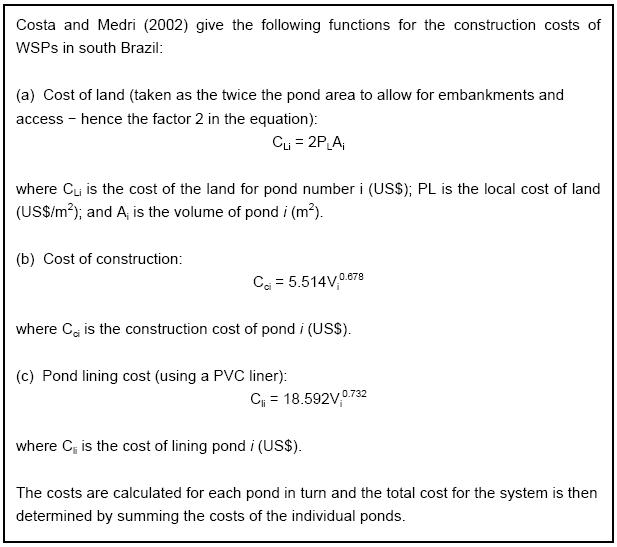
It is not uncommon for manufacturers of electromechanical wastewater treatment equipment to denigrate WSPs, often by exaggerating their land area requirements, claiming that they can be expected to have serious odour problems, or even
saying that they are too low-tech for the 21st century, especially for "large, modern cities". Dont believe
it! WSPs are used for "large, modern cities" - for example, Melbourne, Australia; Amman, Jordan; and Nairobi, Kenya
(details are given in Mara, 2004). Of course, WSPs are not always the best option for large cities, but they should not
be dismissed out of hand, especially on the advice of equipment salesmen.
Reuse of WSP Effluents...
WSPs produce effluents of high microbiological quality that permit them to be used for crop irrigation and/or the
cultivation of fish and aquatic vegetables. WSP effluent reuse for these purposes is described in detail in Section
10 of the India Manual.
Agricultural Reuse...
Crop irrigation is divided into two broad categories: restricted crop irrigation, meaning irrigation of all crops
except salads and vegetables eaten uncooked; and unrestricted irrigation which includes those crops). The World Health Organization has different guidelines for the microbiological quality of treated wastewaters used for these two categories
of irrigation. These guidelines were originally published in 1989 (WHO, 1989) and they are currently under revision (see Blumenthal et al., 2000). The revised guidelines, due to be published in 2005, will be as follows :
( a ) Restricted irrigation : <= 105 E. coli per 100 ml, and <= 1 human intestinal nematode egg per litre, reduced
to <= 0.1 egg per litre when children under the age of 15 are exposed (by working or playing in wastewaterirrigated fields).
( b ) Unrestricted irrigation : <= 1,000 E. coli per 100 ml, and <= 1 human intestinal nematode egg per litre,
reduced to <= 0.1 egg per litre when children under the age of 15 are exposed locally by their field-worker parents
bringing home food crops eaten uncooked.
Faecal coliforms may be substituted for E. coli. The intestinal nematodes are Ascaris lumbricoides (the human roundworm), Trichuris trichiura (the human whipworm) and Ancylostoma duodenale and Necator americanus (the human hookworms). Details
of these nematodes can be found in Sanitation and Disease.
As a general rule (but there are exceptions), a WSP system comprising only anaerobic and facultative ponds produces an effluent suitable for restricted irrigation (or for discharge to a stream, river or lake). Maturation ponds are needed
if the effluent is to be used for unrestricted irrigation or if there are special requirements in terms of microbiological quality for the receiving water body (bathing waters, for example). However, in all cases the appropriate design
calculations must be done to determine whether or not suitable effluents will be produced. These calculations are detailed
in Section 4 of the India Manual. They are briefly described in below :
Removal of Nematode Eggs and E Coli in WSPs...
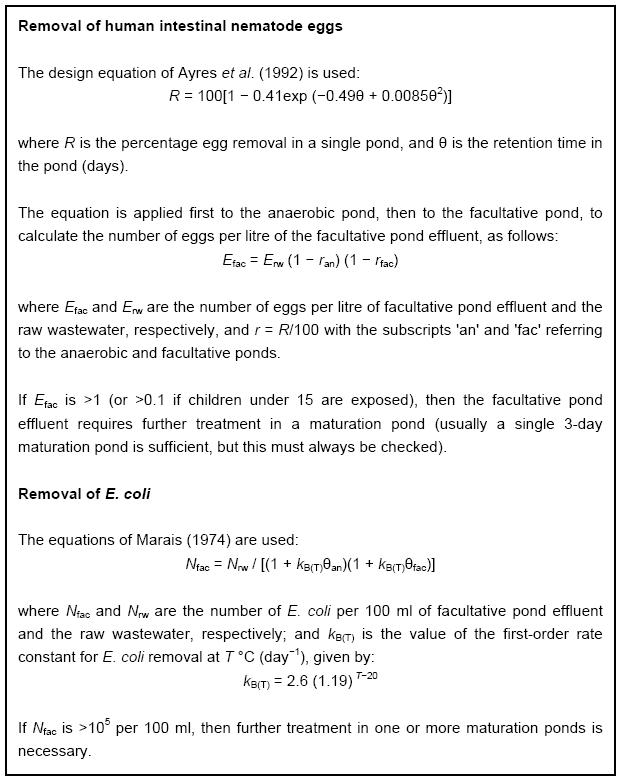
Aquacultural Reuse...
The fish most commonly grown in wastewater-fed fishponds are carp and tilapia (see Figure 10). Details of wastewater-fed fishponds in metropolitan Kolkata, India are given in Section 2 of the India Manual. The revised WHO microbiological
quality guidelines for aquacultural reuse will be : <= 104 E. coli per 100 ml of fishpond water (or aquatic vegetable pond water), and zero detectable human trematode eggs per litre of treated wastewater. Faecal coliforms may be substituted for
E. coli. The human trematodes are Schistosoma spp. (human blood flukes) Clonorchis sinensis (oriental liver fluke) and Fasciolopsis buski (giant intestinal fluke). Details of these trematodes are given in Sanitation and Disease.
Wastewater-fed fishponds are designed to receive facultative pond effluent on the basis of a total nitrogen loading on
the fishpond of 4 kg N / ha . day. Checks are then made to determine whether the E. coli count in the fishpond is <= 104
per 100 ml and whether the free ammonia ( NH3 ) concentration in the fishpond is <= 0.5 mg N / L (higher concentrations are toxic to fish).
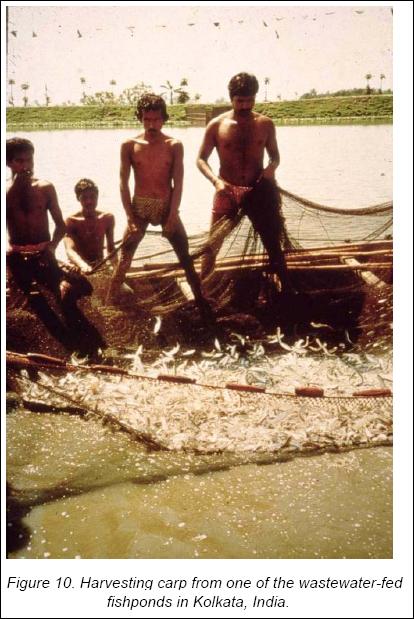 Methane Recovery From Covered Anaerobic Ponds...
Biogas (methane and carbon dioxide) can be profitably recovered from anaerobic ponds if they are covered with a floating plastic membrane. This is done at the Western Treatment Plant in Melbourne, Australia, where the three large WSP systems
each receive a wastewater flow of 120,000 m3 / day. Half of the anaerobic section of the first pond is covered (Figure 11) and the biogas collected is used to generate 6,000 kW of electricity 816 hours per day, 365 days per year,
which is worth about US $ 1 million per year (DeGarie et al., 2000). The cover has three layers: a high-tensile
UV-resistant geo-membrane for biogas recovery at the top; a 12.5 mm polyfoam insulation and flotation layer in the
middle; welded to a base layer of high-density polyethylene. The cover measures 171 Χ 200 m (an area of 3.4 ha). So,
biogas recovery from anaerobic ponds is obviously feasible at large WSP sites, but it has also been done at smaller
sites - for example, at Arad (population 22,000) in the Negev desert, Israel (Shelef and Azov, 2000). Biogas recovery is especially feasible if high-rate anaerobic ponds are used (see Pena, 2002).
Methane Recovery From Covered Anaerobic Ponds...
Biogas (methane and carbon dioxide) can be profitably recovered from anaerobic ponds if they are covered with a floating plastic membrane. This is done at the Western Treatment Plant in Melbourne, Australia, where the three large WSP systems
each receive a wastewater flow of 120,000 m3 / day. Half of the anaerobic section of the first pond is covered (Figure 11) and the biogas collected is used to generate 6,000 kW of electricity 816 hours per day, 365 days per year,
which is worth about US $ 1 million per year (DeGarie et al., 2000). The cover has three layers: a high-tensile
UV-resistant geo-membrane for biogas recovery at the top; a 12.5 mm polyfoam insulation and flotation layer in the
middle; welded to a base layer of high-density polyethylene. The cover measures 171 Χ 200 m (an area of 3.4 ha). So,
biogas recovery from anaerobic ponds is obviously feasible at large WSP sites, but it has also been done at smaller
sites - for example, at Arad (population 22,000) in the Negev desert, Israel (Shelef and Azov, 2000). Biogas recovery is especially feasible if high-rate anaerobic ponds are used (see Pena, 2002).
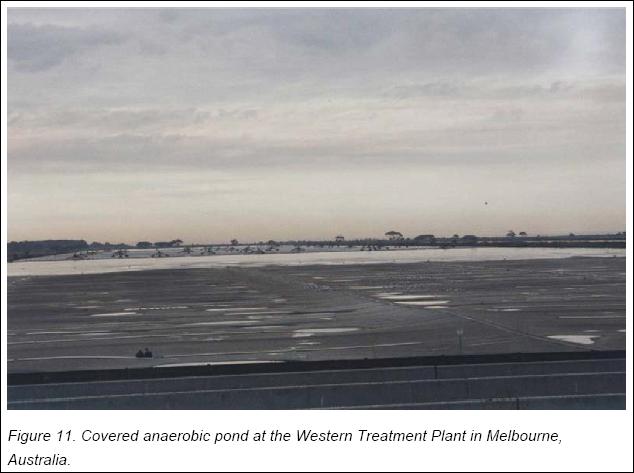 Operation and Maintenance of WSPs...
WSP Start - Up...
Before commissioning a WSP system, any vegetation growing in the empty ponds must be removed. The facultative ponds
and maturation ponds are commissioned before the anaerobic ponds so as to avoid odour release when the anaerobic pond effluent discharges into empty facultative ponds. The facultative ponds and maturation ponds should ideally be filled initially with fresh surface water or groundwater to permit the development of the required algal and heterotrophic
bacterial populations. If freshwater is not available, then the facultative pond can be filled with raw wastewater and allowed to rest in batch mode for 3-4 weeks to allow the microbial populations to develop. Some odour release may be
expected during this period. Once the facultative ponds and maturation ponds have been commissioned, the anaerobic ponds
are filled with raw wastewater and, if possible, inoculated with active biomass (sludge seed) from another anaerobic bioreactor. The anaerobic ponds are then loaded gradually up to their design load over a period of 2-4 weeks (the time depends on whether the anaerobic pond was inoculated with an active sludge seed or not). The pH of the anaerobic pond
has to be maintained at around 7-7.5 during the start-up to allow for the methanogenic archaeal populations to develop.
If the pH falls below 7 during this period, lime should be added to correct it.
Routine Maintenance...
Once the ponds have started functioning in steady state, routine maintenance is minimal but essential for good operation. Full details are given in Section 6 of the India Manual - 10. The main routine maintenance activities are :
Operation and Maintenance of WSPs...
WSP Start - Up...
Before commissioning a WSP system, any vegetation growing in the empty ponds must be removed. The facultative ponds
and maturation ponds are commissioned before the anaerobic ponds so as to avoid odour release when the anaerobic pond effluent discharges into empty facultative ponds. The facultative ponds and maturation ponds should ideally be filled initially with fresh surface water or groundwater to permit the development of the required algal and heterotrophic
bacterial populations. If freshwater is not available, then the facultative pond can be filled with raw wastewater and allowed to rest in batch mode for 3-4 weeks to allow the microbial populations to develop. Some odour release may be
expected during this period. Once the facultative ponds and maturation ponds have been commissioned, the anaerobic ponds
are filled with raw wastewater and, if possible, inoculated with active biomass (sludge seed) from another anaerobic bioreactor. The anaerobic ponds are then loaded gradually up to their design load over a period of 2-4 weeks (the time depends on whether the anaerobic pond was inoculated with an active sludge seed or not). The pH of the anaerobic pond
has to be maintained at around 7-7.5 during the start-up to allow for the methanogenic archaeal populations to develop.
If the pH falls below 7 during this period, lime should be added to correct it.
Routine Maintenance...
Once the ponds have started functioning in steady state, routine maintenance is minimal but essential for good operation. Full details are given in Section 6 of the India Manual - 10. The main routine maintenance activities are :
Removal of screenings and grit from the preliminary treatment units
Periodically cutting the grass on the pond embankments
Removal of scum and floating macrophytes from the surface of facultative ponds and maturation ponds. This is done to maximise the light energy reaching the pond algae, increase surface re-aeration, and prevent fly and mosquito breeding
If flies are breeding in large numbers on the scum on anaerobic ponds, the scum should be broken up and sunk with a water jet
Removal of any material blocking the pond inlets and outlets
Repair of any damage to the embankments caused by rodents or rabbits (or any other burrowing animals)
Repair of any damage to fences and gates
As a rough guide one full-time operator is required at WSPs receiving wastewater flows up to about
1,000 m3 / day, two operators for wastewaters flows up to about 2,500 m3 / day and pro rata for
higher flows (Arthur, 1983). A foreman/supervisor is required at sites treating more than 5,000 m3 / day; and should also keep a record of all maintenance activities, measure and record the wastewater flow and carry out routine effluent sampling.
All WSP operators should receive adequate training so that they understand what they have to do and how to do it
correctly. If, for example, the pond operators have not been told to remove scum from facultative ponds and maturation
ponds, they will not know that it should be removed. As a result, scum can cover a substantial part of the pond, algal
photosynthesis becomes impossible, and the pond turns anoxic (Figure 12).
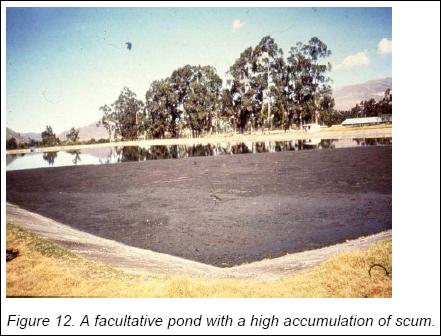
Anaerobic ponds need to be desludged when they are around one-third full of sludge. This occurs every 2-5 years, but it
is operationally better to remove some sludge every year (as a task to be done every February, for example, has a better chance of being done on time than one which has to be done every few years). The sludge removed from anaerobic ponds can
be dewatered on sludge drying beds (Figure 13). Facultative ponds store any sludge for their design life, which is a significant operational advantage. When the travel time in the sewers is long (more than a day), the wastewater arriving
at the WSP site may be highly septic, and that can cause odour from the preliminary treatment works.
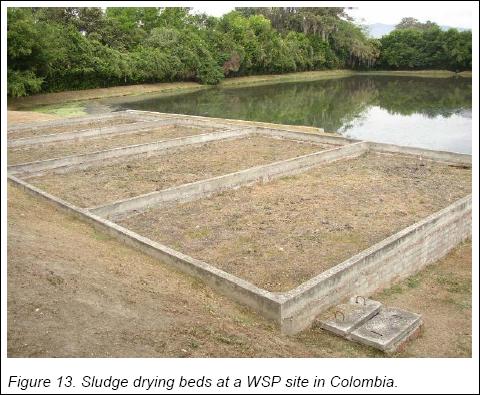 WSP Effluent Quality Monitoring...
The quality of the final effluent should be regularly determined at all WSP sites. For large systems this should be
done monthly, and for small systems serving just a few thousand people at least every three months. Samples should be analysed for those parameters for which the effluent standards have been set by the local environmental regulator
(usually BOD5, suspended solids, pH, possibly also ammonia; and, if the effluent is reused in agriculture,
E. coli or faecal coliforms and helminth eggs). It is important to take representative samples: 24-hour flow-weighted composite samples are required for BOD5, suspended solids, ammonia and helminth eggs; and grab samples for
pH and E. coli/faecal coliforms. Details are given in Section 7 of the India Manual - 11 (see also Pearson et al., 1987). This is an important stipulation because if the samples taken are not truly representative, the analytical results will
not be meaningful and could lead to inappropriate design criteria being developed.
Problems Encountered with WSPs...
WSPs are essentially a simple technology, but some common problems tend to occur regularly. These are generally the
results of mistakes made during design, construction and operation.
Design and Construction...
WSP design is often poor as too many designers do not understand the microbiological processes occurring in them. They
may think that, because ponds are "simple", it is not strictly necessary to follow the correct design procedures. Either
they do not know what these are, or they apply design criteria from temperate climates to the design of WSPs in the
tropics). Some are also unaware of the basic principles for the physical design of WSPs. The result of this regrettable ignorance is that many WSPs have been "designed" with inappropriate BOD5 loadings. Inappropriately high
loadings lead to odour and pond failure; inappropriately low loadings, especially on anaerobic ponds, lead to under-performance and overall costs are increased as the land area used is greater than necessary. Inlets and outlets
are often incorrectly located (Figures 14 and 15) - indeed pond hydrodynamics is rarely considered. In some cases, there
is no provision for preliminary treatment (screening and grit removal), which adversely affects the ponds because of too
much scum and a higher rate of sludge accumulation. Pond failure or poor performance is also caused by inadequate attention being given to geotechnical aspects during the physical design of WSPs (Bernhard and Kirchgessner, 1987; Mantilla et al., 2002).
WSP Effluent Quality Monitoring...
The quality of the final effluent should be regularly determined at all WSP sites. For large systems this should be
done monthly, and for small systems serving just a few thousand people at least every three months. Samples should be analysed for those parameters for which the effluent standards have been set by the local environmental regulator
(usually BOD5, suspended solids, pH, possibly also ammonia; and, if the effluent is reused in agriculture,
E. coli or faecal coliforms and helminth eggs). It is important to take representative samples: 24-hour flow-weighted composite samples are required for BOD5, suspended solids, ammonia and helminth eggs; and grab samples for
pH and E. coli/faecal coliforms. Details are given in Section 7 of the India Manual - 11 (see also Pearson et al., 1987). This is an important stipulation because if the samples taken are not truly representative, the analytical results will
not be meaningful and could lead to inappropriate design criteria being developed.
Problems Encountered with WSPs...
WSPs are essentially a simple technology, but some common problems tend to occur regularly. These are generally the
results of mistakes made during design, construction and operation.
Design and Construction...
WSP design is often poor as too many designers do not understand the microbiological processes occurring in them. They
may think that, because ponds are "simple", it is not strictly necessary to follow the correct design procedures. Either
they do not know what these are, or they apply design criteria from temperate climates to the design of WSPs in the
tropics). Some are also unaware of the basic principles for the physical design of WSPs. The result of this regrettable ignorance is that many WSPs have been "designed" with inappropriate BOD5 loadings. Inappropriately high
loadings lead to odour and pond failure; inappropriately low loadings, especially on anaerobic ponds, lead to under-performance and overall costs are increased as the land area used is greater than necessary. Inlets and outlets
are often incorrectly located (Figures 14 and 15) - indeed pond hydrodynamics is rarely considered. In some cases, there
is no provision for preliminary treatment (screening and grit removal), which adversely affects the ponds because of too
much scum and a higher rate of sludge accumulation. Pond failure or poor performance is also caused by inadequate attention being given to geotechnical aspects during the physical design of WSPs (Bernhard and Kirchgessner, 1987; Mantilla et al., 2002).
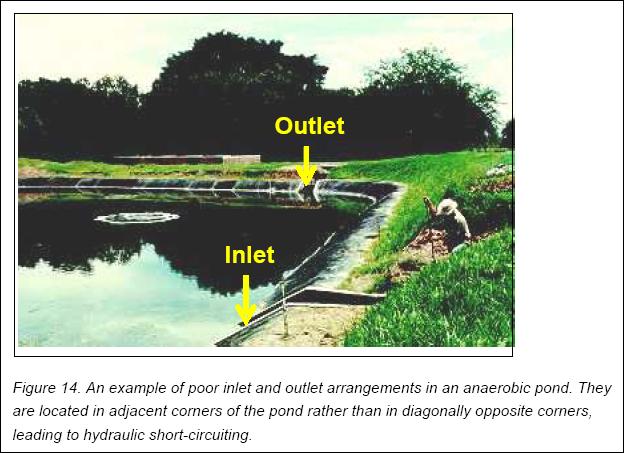
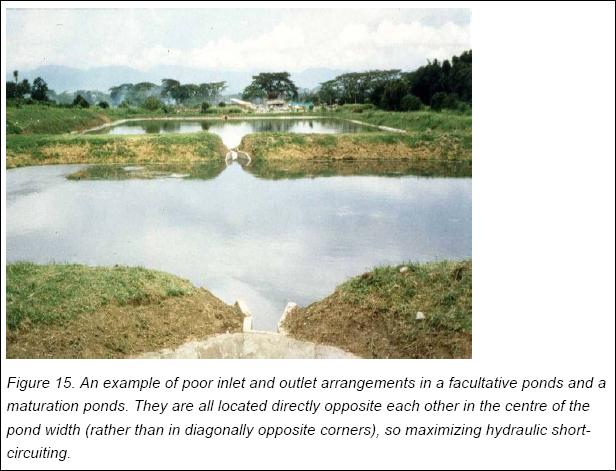
Lloyd et al. (2003) studied 14 WSP systems in Mexico: all produced poor quality effluents. The reasons for
under-performance included gross under-design, adverse environmental conditions, a very high degree of hydraulic short-circuiting, and very poor operation and maintenance. The main adverse environmental conditions were the large
diurnal variations in temperature in winter (from - 4 O C to + 30 O C) and very high wind speeds
(peaks of more than 8 m / sec), both of which were major factors in the excessive hydraulic shortcircuiting. In one pond
the dead space was 80 percent of the pond volume).
Another common problem is that, despite the loading rates being correctly selected by the designer, based on reasonable values of the key design parameters, such as population, per caput wastewater flow and BOD5 contribution, the actual influent loads are different. The actual loading at the start may be much lower than the design value used, leading
to critical underloading in the anaerobic ponds; or it may increase at a greater rate than predicted in the design, so
leading to early critical overloading in the anaerobic and facultative ponds. Inappropriate changes made during
construction can also adversely affect pond performance. For example, it has been found in Colombia that contractors sometimes decide to change the pond length-to-breadth ratio and/or increase the depth, or fail to install the lining
material correctly. They do this in the misguided belief that WSPs are just holes in the ground and everything will be
fine as long as the pond volumes are more or less correct. They get away with it because their site work is not adequately supervised by the designer or an independent civil/environmental engineer.
Routine Maintenance...
The simplicity of routine WSP maintenance is sometimes mistakenly interpreted as "low maintenance equals no maintenance".
As a result, routine preventive maintenance is often not done, or not done correctly, and the WSPs are "maintained" only
when a serious problem has developed - for example, odour, mosquito breeding, excessive sludge accumulation in anaerobic ponds, or excessive vegetation growth in facultative ponds and maturation ponds (Figure 16).
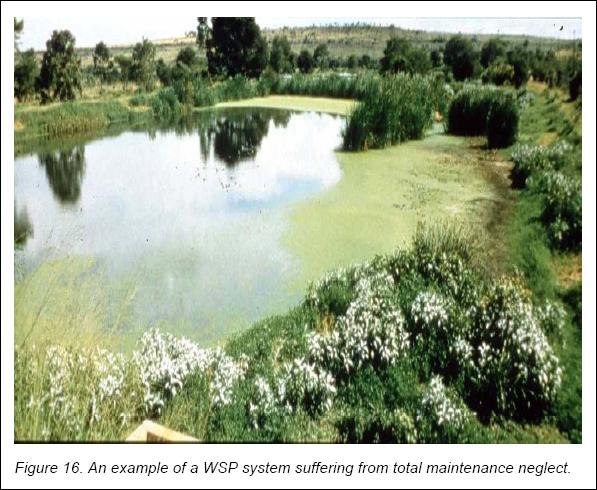
Training...
Professional staff involved in WSP projects include design and construction engineers, engineers responsible for operation
of the WSPs once commissioned, and chemical and microbiological laboratory managers and analysts. Financial analysts and sociologists may also be involved at the pre-design and design stages. It is now becoming more common for the local
community to be involved at these stages; among other things, local residents may need reassurance that WSPs will not cause odour problems, etc. All the professionals require appropriate training. Ideally, this is best done at a university or
technical college, but that requires specialist lecturers who teach up-to-date curricula, and this is not so common in many universities and colleges. Few local professional institutions, such as national environmental engineering associations,
take continuous professional development (CPD) seriously, yet CPD is necessary to keep professionals up to date in their specialism.
Other Type of Ponds...
Sections 1.1-1.8 have dealt with conventional free-surface WSP systems. Some other types of pond systems merit discussion :
Wastewater Storage and Treatment Reservoirs (WSTR)...
WSTR were developed in Israel to store the effluent from a WSP system during the nonirrigation period, so that the whole year's treated wastewater could be used in the irrigation season, permitting a much greater area to be irrigated and more crops produced (Juanico and Shelef, 1991). WSTR are especially suitable in arid and semi-arid areas where the value of treated wastewater for irrigation is high. Current practice is to treat the wastewater in an anaerobic pond and discharge
the effluent into a single 5-20 m deep WSTR with a retention time equal to the length of the non-irrigation season (Figure 17a). This is perfectly satisfactory if only restricted irrigation is practised. If unrestricted irrigation is intended, three or four sequential batch-fed WSTR are required to achieve the WHO guideline for unrestricted irrigation (Mara and Pearson, 1992) (Figure 17b). These sequential batch-fed WSTR are operated on a cycle of fill, rest and use, such that
the E. coli count in a reservoir at the end of its rest phase (i.e., just before it is used for irrigation) is less than
1,000 per 100 ml.
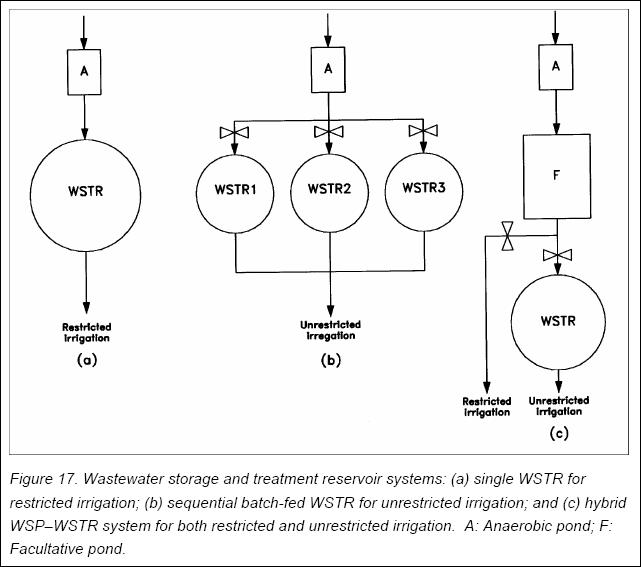
Hybrid WSPs-WSTR systems provide treated wastewater for both restricted and unrestricted irrigation (Mara and Pearson,
1999) (Figure 17c).
Floating macrophyte ponds : These ponds contain plants that float on the water with their leaves close to the
surface and their roots hanging down into the pond water column to absorb nutrients. Some plant types commonly used are Eichhornia sp. (water hyacinth), Lemna sp. (duckweed), Pistia sp. (water lettuce or water cabbage) and Cyperus sp.
(papyrus). The plants shade out the algae, so reducing effluent BOD5 and suspended solids; however, this has
the disadvantage that disinfection is reduced, with the result that effluent E. coli numbers are higher. This suggests
that floating macrophyte ponds should only be used as a final treatment stage (for nutrient and algal removal) after
conventional maturation ponds have reduced E. coli numbers to the required level. However, if the final effluent is used
for crop irrigation, nutrient and algal removal is unnecessary and floating macrophyte ponds are therefore not required.
A major disadvantage with floating macrophyte ponds is that they encourage mosquito breeding. Culicine mosquitoes, the
vector of Bancroftian filariasis, are the principal problem, but Eichhornia ponds permit the breeding of anopheline
mosquitoes, the malaria vector, as well.
Septage and nightsoil ponds : Septage is the sludge removed from septic tanks; it also contains much of the
wastewater fraction in the septic tank as this is generally also pumped out during septic tank desludging. The sludge fraction is highly mineralized, so treatment in anaerobic ponds is not required. The BOD5 of septage is very
high, often 3,000-5,000 mg/l. Treatment is in several facultative ponds in parallel, designed on the basis that
evaporative losses in the coolest month equal the inflow and no effluent is produced. The BOD5 surface
loading on the facultative ponds should not exceed the value for the temperature of the coolest month (Box 1). Make-up
water is added in other months to maintain the pond depth, which means that septage ponds should be located near a reliable source of water. Nightsoil ponds are not very common, as bucket latrines are increasingly being replaced by more appropriate sanitation technologies. Nightsoil treatment ponds (anaerobic ponds + facultative ponds) are designed in the normal way
(Box 1) for a BOD5 contribution of about 20 g/person day. Suitable arrangements have to be made for the nightsoil tankers to discharge their loads into the anaerobic ponds. Tanker wash water is also discharged into the anaerobic ponds.
Advanced integrated pond systems (AIPS) : AIPS were developed from high-rate algal ponds (HRAPs) (Oswald, 1991, 1995). They comprise "advanced" facultative ponds with a submerged anaerobic digestion pit, paddle-stirred HRAP, algal sedimentation ponds and one or more maturation ponds. The original purpose of HRAPs was to maximize the production of algae to recover and use the algal protein (algae are 50-60 percent protein and HRAPs can produce up to 80 tonnes of algal protein/ha year). However, with AIPS no attempt is made to recover the algal protein. HRAPs, which are the key component
of AIPS, are complex and sensitive reactors which are much more difficult to operate correctly than conventional WSPs (and indeed activated sludge processes). In the real world of wastewater treatment in developing countries, AIPS are too complicated a technology to be considered a viable and sustainable treatment option.
Lessons Learnt...
Experience from around the world has shown that WSPs are very often the most costeffective wastewater treatment method. However, both the process design and the physical design of WSPs have to be carried out very carefully by competent
design engineers since WSPs are more than just holes in the ground. Effluents from WSPs can achieve stringent discharge standards that make them highly suitable for reuse in agriculture and/or aquaculture. This puts WSPs at the forefront of
wastewater reclamation technologies. Despite more than 50 years of continued research into different aspects of WSPs,
there is still much work to do on topics such as hydrodynamic improvement, ecological modelling and enhancement of removal rates (i.e., organic matter, nutrients and pathogens). Such research should be aimed at developing efficient WSP systems
that require less land. Training is needed to ensure that practising engineers properly understand WSP technology and so
are able to design new WSPs and upgrade existing WSP systems correctly. Good operation and maintenance by adequately
trained operators is fundamental to guarantee the long-term sustainability of WSPs systems.
Research Perspectives...
Recent research has shown that it should be possible to improve the performance of all types of WSPs (i.e. anaerobic ponds, facultative ponds and maturation ponds). For example, the recent development of high-rate anaerobic ponds has shown that
it is possible to reduce the retention time to 12 hours, yet still achieve average BOD5 removals of 70 percent
at 25 O C (Pena, 2002). Future research should investigate high-rate facultative ponds and maturation ponds to treat the effluents from both high-rate anaerobic ponds and UASBs. Mechanistic modelling of the microbiological and biological processes occurring in WSPs is probably the most difficult area of research, especially in relation to nutrient
(N and P) removal. However, the combination of high-power computing, computational fluid dynamics packages, molecular
biology and ecological engineering techniques is likely to help the development of both more rational design procedures
and dynamic models to predict WSP performance under changing conditions. There are already promising results showing that simple engineering interventions such as the intelligent incorporation of baffles and flow deflectors can greatly improve
WSP performance. Shilton and Harrison (2003) show that this opens new perspectives for the improvement of the physical
design of WSPs.


























